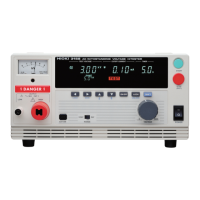87
────────────────────────────────────────────────────
7.3 Command Transfer Methods
────────────────────────────────────────────────────
1
2
3
4
5
7
9
10
11
12
13
14
A
NOTE
NOTE
7.3 Command Transfer Methods
The command is issued from the computer.
When the 3158 receives the incoming command from the computer, it executes the
processing specified by the command.
When 3158 has completed processing of the command, it always returns a response
to the computer.
When the computer has confirmed the response, it sends the next command.
RMT lights up on the screen during interface communication.
・
Every time the computer has sent a command, a response is always returned.
Make sure that the computer only sends the next command after it has received
the response to the previous command issued from the 3158.
If multiple commands are sent consecutively, the 3158 may not execute the
commands, or command errors may occur.
・
There is a need to add ":" to the front of the command except standard commands
in the instrument.
Command Format
The 3158 commands have the following structure.
Command
+
Parameter
+
Delimiter
The command and the parameter are separated by " " ( one character space )
If there is no parameter, send the delimiter after the command.
The command may consist of both upper and lower case letters.
Make sure to use one character space as the separator between the command and
the parameter.
(1) When the command contains a parameter
:CONF:CUPP5.0(+delimiter)
The command format consists of the command ":CONF:CUPP" followed by
the separator "".Then follows the parameter "5.0". Following the
parameter comes the delimiter.
(2) When the command contains no parameter
:STOP ( + delimiter )
The command format consists of the command ":STOP" immediately followed
by the delimiter.
The meaning of the delimiter is to separate commands and data. When the 3158
receives the delimiter, it starts analysis of the command.

